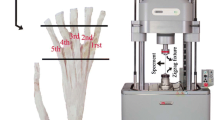Abstract
Plantar heel pain is a commonly encountered orthopedic problem and is most often caused by plantar fasciitis. In recent years, different shapes of insole have been used to treat plantar fasciitis. However, little research has been focused on the junction stress between the plantar fascia and the calcaneus when wearing different shapes of insole. Therefore, this study aimed to employ a finite element (FE) method to investigate the relationship between different shapes of insole and the junction stress, and accordingly design an optimal insole to lower fascia stress.
A detailed 3D foot FE model was created using ANSYS 9.0 software. The FE model calculation was compared to the Pedar device measurements to validate the FE model. After the FE model validation, this study conducted parametric analysis of six different insoles and used optimization analysis to determine the optimal insole which minimized the junction stress between plantar fascia and calcaneus.
This FE analysis found that the plantar fascia stress and peak pressure when using the optimal insole were lower by 14% and 38.9%, respectively, than those when using the flat insole. In addition, the stress variation in plantar fascia was associated with the different shapes of insole.








Similar content being viewed by others
References
ANSYS Inc. Design Optimization. ANSYS Theory Reference Release 9.0., 2004
Athanasiou K. A, G. T. Liu, L. A. Lavery, D. R. Lanctot, R. C. Schenck Jr Biomechanical topography of human articular cartilage in the first metatarsophalangeal joint. Clin. Orthop. 348:269–281, 1998. doi:10.1097/00003086-199803000-00038
Chen W. P., C. W. Ju, F. T. Tang. Effects of total contact insoles on the plantar stress redistribution: a finite element analysis. Clin. Biomech. 18(6):S17–24, 2003. doi:10.1016/S0268-0033(03)00080-9
Cheung J. T., M. Zhang, K. N. An. Effects of plantar fascia stiffness on the biomechanical responses of the ankle-foot complex. Clin. Biomech. 19(8):839–846, 2004. doi:10.1016/j.clinbiomech.2004.06.002
Cheung J. T., M. Zhang, K. N. An. Effect of Achilles tendon loading on plantar fascia tension in the standing foot. Clin. Biomech. 21(2):194–203, 2006. doi:10.1016/j.clinbiomech.2005.09.016
Cheung J. T., M. Zhang, J. T. Cheung, M. Zhang. A 3-dimensional finite element model of the human foot and ankle for insole design. Arch. Phys. Med. Rehabil. 86(2):353–358, 2005. doi:10.1016/j.apmr.2004.03.031
Cole C., C. Seto, J. Gazewood. 2005 Plantar fasciitis: evidence-based review of diagnosis and therapy. Am. Fam. Physician 72(11):2237–2242
Gefen, A. Stress analysis of the standing foot following surgical plantar fascia release. J. Biomech. 35(5):629–637, 2002. doi:10.1016/S0021-9290(01)00242-1
Gefen, A. Plantar soft tissue loading under the medial metatarsals in the standing diabetic foot. Med. Eng. Phys. 25(6):491–499, 2003. doi:10.1016/S1350-4533(03)00029-8
Gefen A., M. Megido-Ravid, Y. Itzchak, M. Arcan. Biomechanical analysis of the three-dimensional foot structure during gait: a basic tool for clinical applications. J. Biomech. Eng. 122(6):630–639, 2000. doi:10.1115/1.1318904
Goske S., A. Erdemir, M. Petre, S. Budhabhatti, P. R. Cavanagh. Reduction of plantar heel pressures: insole design using finite element analysis. J. Biomech. 39(13):2363–2370, 2006. doi:10.1016/j.jbiomech.2005.08.006
Huang T. H., C. K. Feng, Y. W. Gung, M. W. Tsai, C. S. Chen, C. L. Liu. Optimization design of thumbspica splint using finite element method. Med. Biol. Eng. Comput. 44(12):1105–1111, 2006. doi:10.1007/s11517-006-0131-4
Irving D. B., J. L. Cook, H. B. Menz. Factors associated with chronic plantar heel pain: a systematic review. J. Sci. Med. Sport 9(1–2):11–22, 2006; discussion 23–14
Kitaoka H. B., Z. P. Luo, E. S. Growney, L. J. Berglund, K. N. An Material properties of the plantar aponeurosis. Foot Ankle Int. 15:557–560, 1994
Kitaoka H. B., Z. P. Luo, H. Kura, K. N. An. Effect of foot orthoses on 3-dimensional kinematics of flatfoot: a cadaveric study. Arch. Phys. Med. Rehabil. 83(6):876–879, 2002. doi:10.1053/apmr.2002.32681
Kogler G. F., S. E. Solomonidis, J. P. Paul. Biomechanics of longitudinal arch support mechanisms in foot orthoses and their effect on plantar aponeurosis strain. Clin. Biomech. 11(5):243–252, 1996. doi:10.1016/0268-0033(96)00019-8
Kogler G. F., F. B. Veer, S. J. Verhulst, S. E. Solomonidis, J. P. Paul. The effect of heel elevation on strain within the plantar aponeurosis: in vitro study. Foot Ankle Int. 22(5):433–439, 2001
Landorf K. B., A. M. Keenan, R. D. Herbert, K. B. Landorf, A. M. Keenan, R. D. Herbert. Effectiveness of foot orthoses to treat plantar fasciitis: a randomized trial. Arch. Intern. Med. 166(12):1305–1310, 2006. doi:10.1001/archinte.166.12.1305
Liao Y. C., C. K. Feng, M. W. Tsai, C. S. Chen, C. K. Cheng, Y. C. Ou. Shape modification of the Boston brace using a finite-element method with topology optimization. Spine 32(26):3014–3019, 2007
Riddle, D. L., M. Pulisic, P. Pidcoe, and R. E. Johnson. Risk factors for Plantar fasciitis: a matched case-control study.[erratum appears in J Bone Joint Surg Am. 2003 Jul;85-A(7):1338]. J. Bone Joint Surg. Am. 85-A(5):872–877, 2003
Seligman D. A., D. R. Dawson. Customized heel pads and soft orthotics to treat heel pain and plantar fasciitis. Arch. Phys. Med. Rehabil. 84(10):1564–1567, 2003. doi:10.1016/S0003-9993(03)00363-0
Simkin, A. Structural analysis of the human foot in standing posture. Ph.D. Thesis, Tel Aviv University, Tel Aviv, 1982
Wu, L. Nonlinear finite element analysis for musculoskeletal biomechanics of medial and lateral plantar longitudinal arch of Virtual Chinese Human after plantar ligamentous structure failures. Clin. Biomech. (Bristol, Avon) 22(2):221–229, 2007. doi:10.1016/j.clinbiomech.2006.09.009
Zhong Z. C., S. H. Wei, J. P. Wang, C. K. Feng, C. S. Chen, C. H. Yu. Finite element analysis of the lumbar spine with a new cage using a topology optimization method. Med. Eng. Phys. 28(1):90–98, 2006. doi:10.1016/j.medengphy.2005.03.007
Author information
Authors and Affiliations
Corresponding author
Rights and permissions
About this article
Cite this article
Hsu, YC., Gung, YW., Shih, SL. et al. Using an Optimization Approach to Design an Insole for Lowering Plantar Fascia Stress—A Finite Element Study. Ann Biomed Eng 36, 1345–1352 (2008). https://doi.org/10.1007/s10439-008-9516-x
Received:
Accepted:
Published:
Issue Date:
DOI: https://doi.org/10.1007/s10439-008-9516-x




